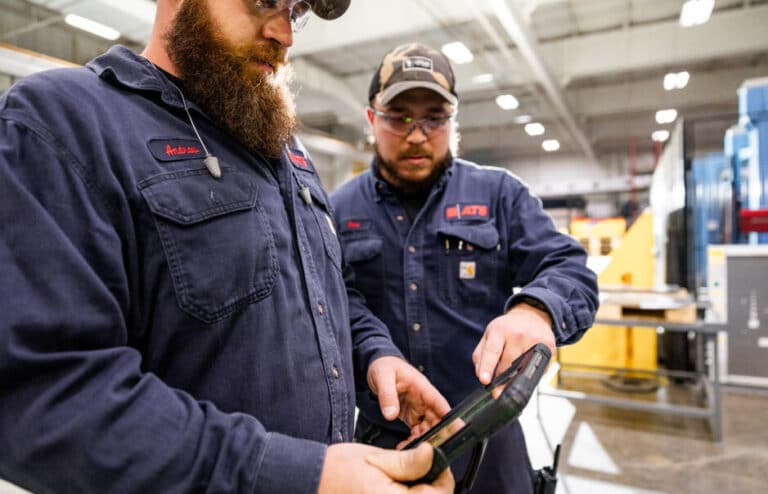With the rapid rise of artificial intelligence (AI), the future of inventory management in manufacturing facilities is here.
AI is proving to be a significant change for industries around the globe, and manufacturing is no exception. At its core, AI for managing parts inventory holds the potential to revolutionize everything from production to maintenance offering a wide range of solutions to streamline and optimize processes.
In this guide, we’re going to dive into how AI and machine learning inventory management are defining the future of spare parts management. We’ll explore how these cutting-edge technologies can trim inefficiencies, unlock enormous economic benefits and ultimately enhance bottom line performance.
The potential is simply astounding: We’re talking about reaching into businesses to unlock up to $1.1 trillion dollars in tied up in inventory in the US alone.
As for maintenance in manufacturing facilities? The implications are even more profound. Think shorter customer lead times, accurate forecasting of stock levels and even having a safety net for unexpected production hiccups. Let’s look at the real power of AI when it comes to spare parts or MRO parts inventory management.
How AI can improve inventory management
Ever wondered how AI can improve inventory management for manufacturers and producers? In this section, we’ll look at how AI helps in optimizing inventory levels, improves cost of goods sold (COGS), streamlines warehouse operations and “fine tunes” lead times to meet customer demands.
Analyzing & optimizing inventory level efficiently
Maintaining the right inventory levels is a delicate balance, and AI can lend a hand. Advanced AI algorithms can analyze and learn from previous orders and supplier demands making accurate predictions to optimize stock levels.
Also, AI-based inventory management can keep track of inventory, sales trends and demand to avoid piles of unused products sitting in warehouses tying up cash and space. With precise data interpretation, AI allows for accurate forecasting to prevent overstocking or understocking, a problem that’s costing businesses worldwide billions of dollars.
Improved cost of goods sold
When it comes to managing finances in manufacturing, we all know that inventory is often the most significant variable. AI’s potential to unlock around about a trillion dollars currently tied up in US business inventory is a significant development.
It does this by analyzing millions of purchases to predict fast-selling and slow selling items by region and season. Businesses can then order based on real-time demand signals rather than predictions alone leading to improved costs of goods sold.
Optimized lead times
The ability to deliver on time is critical in maintaining customer trust and reliability. Using Industry 4.0 technologies such AI, IoT and sensors, manufacturing facilities can predict gaps in inventory and order correct amounts of materials based on ERP and consumer trends data. This access to data-driven decision-making allows for shorter customer lead times and increased customer satisfaction.
Streamlining warehouse operations
AI for inventory management brings a new level of sophistication to warehouse operations. For one, it supports the development of spare parts strategies and simplifies master data maintenance by identifying existing parts and manufacturer information.
Even further, AI can simulate optimal supply routes and availability locations based on demand and transport times; web crawlers can match company inventories to online supplier information to plan for disruptions. When inventory runs low, AI quickly matches businesses to ready suppliers based on parameters such as cost and delivery.
Concluding thoughts
Understanding how to manage spare parts inventory efficiently and effectively with AI and inventory management is important for every manufacturing company, directly impacting the bottom line and customer satisfaction.
With the introduction of AI and machine learning into modern manufacturing inventory management, there’s no doubt the space is witnessing a revolution. Applying AI for managing parts inventory lets businesses significantly improve and optimize their operations, slim down costs and drive customer satisfaction by ensuring product availability.
By deploying AI-based inventory management systems utilizing AI inventory optimization, companies can automatically order the correct amount of materials based on ERP and consumer trends data. This approach removes the human error factor and speeds up the process. It also saves massive amounts of cash that is otherwise tied up in overstocked or understocked inventory.
Complex decisions around stocking, procurement and inventory management can be simplified with artificial intelligence in manufacturing. This also means that routine work such as master data maintenance, determining manufacturer information or identifying existing parts can be handled more efficiently, thereby freeing up human resources for more strategic roles.
There’s no question that harnessing AI for inventory optimization has far reaching benefits. Whether it’s enhancing customer satisfaction through improved product availability or slashing costs by ensuring optimal stock levels, AI is in a position to redefine traditional inventory management systems.
The future lies in embracing these new technologies to access the true potential of supply chain management in the manufacturing industry.


